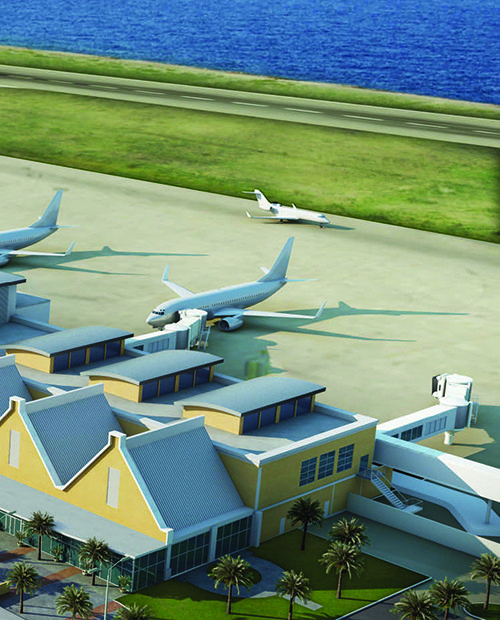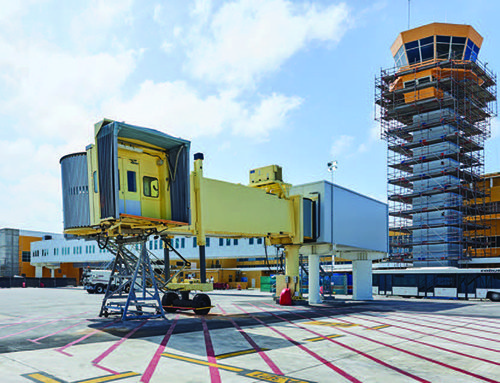Curaçao International Airport (CUR), on the Dutch Caribbean Island of Curaçao, is in the home stretch of a $36.4 million expansion and renovation to increase its capacity from 1.6 million to 2.5 million passengers per year. The sweeping project will also update the terminal’s look and improve operating efficiency for the growing number of tourists who visit the beach and scuba diving haven.
Curaçao Airport Partners, a consortium of international investors, broke ground on the project in June 2016 and expect it to be completed by this December. The private consortium provided $26.4 million of the cost for the expansion and renovations; the other $10 million was supplied by the Airport Trust Fund, which consists of contributions from Curaçao Airport Holding, the government-owned entity that holds title to the airport, and Curaçao Airport Partners.
The project exceeds its obligations as outlined in the 30-year Development, Operation and Management Agreement the private consortium signed with the government-owned holding company back in 2003. Per the agreement, the consortium opened a new terminal in 2006 to accommodate 1.6 million passengers a year. “Our contract read that when we reached 1.6 million, we would be obligated to design a terminal to accommodate up to 2.5 million, and when it reached 1.8 million, we would start construction,” explains Bryan Elshot, manager of airport development for Curaçao Airport Partners.
|
facts&figures
Project: Terminal Expansion Location: Curaçao Int’l Airport (Curaçao Island, Dutch Caribbean)
Owner & Regulator:
Airport Management: Project Cost: $36.4 million Funding: Curaçao Airport Partners – $26.4 million; Airport Trust Fund (Curaçao Airport Holding & Curaçao Airport Partners) – $10 million Lead Architect: Corgan Associates Project Manager: ICM Consult
Architectural Project Project Advisor: Moedt Property Services General Contractor: ALBO Caribbean
Telecommunication, Security
Structural Engineer:
Mechanical, Electrical Electrical: GEWI Technical Services Heating, Venting & Air Conditioning: CHS Technical Contracting & Trading Co. Baggage: Vanderlande Industries
Boarding Bridge: Seating: Vitra Int’l Elevators/Escalators: OTIS/Caribbean Elevators E-Gates: Vision-Box Tiles: LOT 1038; Royal Mosa Of Note: Public-private partnership is investing in airport development to foster & encourage island development; private operator initiated & executed terminal renovation/expansion before it was contractually required |
Even though CUR had not reached the contractual passenger thresholds, operational strains and the desire to fuel the momentum of local development prompted the private consortium to invest in airport improvements ahead of schedule. In 2014, Curaçao Airport Partners hired Corgan Associates to design an expansion project with new construction and renovations to existing facilities.
Wilhelmus Ignacio, managing director of Curaçao Airport Holding, praises Curaçao Airport Partners for its cooperation with the government and willingness to begin the terminal expansion before it was required.
“Although we reached 1.7 million passengers, we never reached the contract number of 1.8 million,” Ignacio points out. “But the logistics of the airport were not up to par considering today’s standards, and everyone agreed that something had to be done. We are doing more than the contract requires, because everyone wants the airport to be one of the best in the Caribbean. (As the government representative), we could never have done this on our own, because of the tens of millions of dollars it takes to build a class-A terminal.”
 Preparing for the Future
Preparing for the Future
Historically, Curaçao functioned more as a business hub than a tourist destination. Numerous oil refineries were especially prominent. But over the past decade or so, the island’s tourism has grown considerably. As it did, the airport’s shortcomings became more evident and problematic, reflects Ralph Blanchard, chief executive officer of Curaçao Airport Partners.
“For us, the airport expansion represents an opportunity,” he explains. “We see Curaçao as a uniquely appealing and attractive destination to a global travel consumer base. We want to competitively position Curaçao to achieve the traffic success that we believe is within our reach. Our traffic concentration in the European market is already mature, and we are very actively looking to greatly expand consumer awareness of Curaçao in the U.S. market. But the airport’s limitations had to be addressed. The functionality wasn’t there, and space was tight.”
Even though the existing terminal was fairly new, users and stakeholders alike knew it lacked the right efficiencies and amenities for travelers. Something had to be done, notes Blanchard. When the current improvement project is completed later this year, the terminal will be approximately 80% bigger, and in a much better position to accommodate the airport’s 20 air carriers, which provide a mix of regional and international service.
The project’s main challenge, Elshot informs, was finding ways to minimize operational disruptions. Early in the project design phase, stakeholders were interviewed to determine not only what they needed, but also what they wanted—“the small things that make people happier and ultimately translate into a better experience for travelers,” says Elshot.
“We kept our stakeholders aware of what we were going to build and how we were going to build it,” he adds. “We let them know ahead of time the inconveniences they would experience. Everyone felt included.”
While the existing terminal highlights the Dutch Colonial architecture and pastel color scheme that dominate the island, Curaçao Airport Partners wanted the new terminal to have a clean, modern aesthetic to project the future of Curaçao. Increasing capacity and operational efficiencies were other main objectives, notes Corgan Principal John Trupiano.
On the west side of the terminal a 22,000-square-foot addition doubles the holdroom capacity and includes a Code F gate with a new wide-body aircraft jet bridge. The expansion will also add new concessions and a bigger airport-run VIP lounge.
 In the old terminal, a shared arrivals/departures corridor created operational difficulties with gate dependencies. Often, airport staff had to hold up departing travelers while arriving passengers moved through the corridor. To eliminate these issues and improve operational flexibility, the new terminal will include a sterile corridor on the mezzanine level for arriving passengers. Three new screening lanes at the security checkpoint will bring CUR’s total to five.
In the old terminal, a shared arrivals/departures corridor created operational difficulties with gate dependencies. Often, airport staff had to hold up departing travelers while arriving passengers moved through the corridor. To eliminate these issues and improve operational flexibility, the new terminal will include a sterile corridor on the mezzanine level for arriving passengers. Three new screening lanes at the security checkpoint will bring CUR’s total to five.
With the old terminal’s configuration, arriving passengers collected their baggage and proceeded through Customs, then stepped outside, where friends and family waited curbside. The new design relocates Customs, and arriving passengers will be greeted by friends and family in a bright and colorful indoor space with new concessions, new seating and reconfigured rental car counters. The new Arrivals Hall is already proving to be a photo-op landmark for passengers, and the airport plans to host seasonal events in the multipurpose space.
The Immigration Hall has been expanded and reconfigured, with more attention on E-gate processing to reduce wait times. A total of eight E-gates encourage travelers to manage their own clearance by authenticating their passport and verifying their identity through biometric screening.
 Part of the Customs and Arrival Hall relocation included the addition of a wide-body baggage reclaim device. Arriving passengers now pass through a new duty-free shopping area between the baggage claim area and Customs Hall.
Part of the Customs and Arrival Hall relocation included the addition of a wide-body baggage reclaim device. Arriving passengers now pass through a new duty-free shopping area between the baggage claim area and Customs Hall.
A revamped concessions program adds new airside options, including walkthrough duty-free shopping immediately beyond the security checkpoint.
The new terminal also includes a mirador—a much-loved architectural feature of the original airport that was eliminated when the current terminal was built in 2006. The mirador was essentially an observation area that allowed the public to watch airplanes landing and departing, and even wave to loved ones as they boarded and disembarked. It connected the community to the airport, explains Trupiano.
The new mirador is located on the rooftop of the west expansion. A landside stairway and elevator provide public access to the covered observation area. “It was very important to our client that we incorporate a mirador in the new design, and they made a significant investment to make it happen,” says Trupiano. “The goal was to reengage the community with the airport, give something back to the public that had been missing for the past 10-plus years.”
 The Future Looks Bright
The Future Looks Bright
With the project nearly complete, Curaçao Airport Holding and its private consortium partner Curaçao Airport Partners are both enthusiastic about the new terminal and what it will mean for the future of the island.
 “What we are getting goes beyond our expectations,” reflects Ignacio, speaking on behalf of the government entity.
“What we are getting goes beyond our expectations,” reflects Ignacio, speaking on behalf of the government entity.
The private consortium, in turn, sees the terminal project as a tangible expression of its long-term commitment to the airport, government and overall development of Curaçao.
“Approximately 12% of the eastern side of the island is undeveloped,” explains Blanchard. “Going forward, Curaçao can rewrite its tourism product just by looking at that section of the island. We see the airport as a catalyst for growth and for helping the island to plan and execute a master strategy for tourism that will help the island reach its full potential. By the end of 2018, we will have put together a business and operational platform that we believe will accommodate the airport’s and island’s projected traffic demands and that will optimize the value of this national asset for the government as well as the shareholders of the private company responsible for its management and development. The Curaçao International Airport is an excellent example of the success that can be achieved when public and private entities cooperate to develop and manage critical national assets. We’re hoping that we’ll be looking to expand again once we reach 2.5 million passengers—within the next seven years or so if things go as we envision.”


